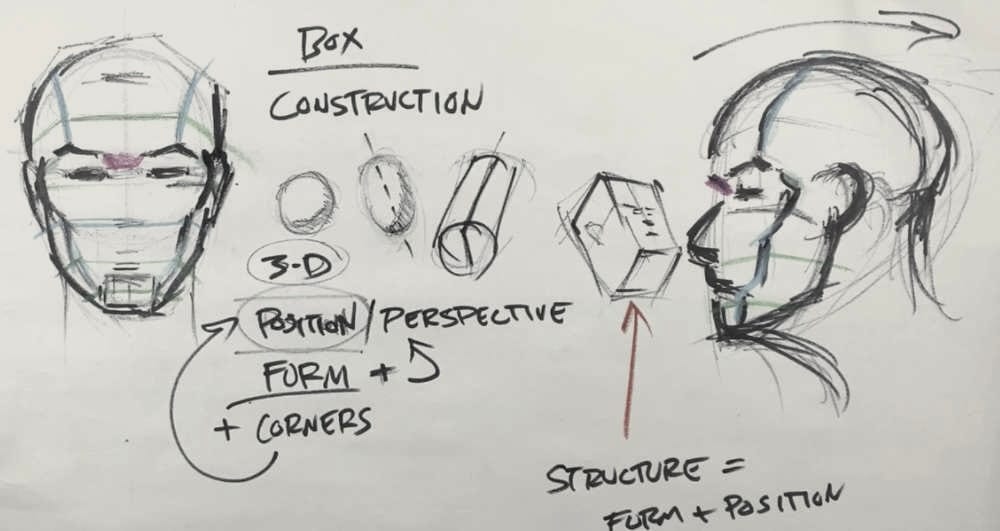Box Construction Part 2: Facial Planes and Landmarks
Break the face into planes using box construction. Learn eyebrow landmarks, the 5-eyes rule, front vs side plane transitions, and how face width changes from forehead to cheeks to jaw.

Now that you understand structure = form + position from the head draw box construction lesson part 1 (that was a mouthful), let's break the face down into actual planes. This is where box construction gets practical.
Watch video: hit play and level up your head drawing skills.
Starting with the Eyebrows
First features you notice on a head? Eyebrows.
Most eyebrows have an arc - they go up, then come back down. Not everyone has a dramatic arch, but there's usually some curve or line there.
This is important because the eyebrow is where things start connecting. It joins the side planes to the front planes. It's where the forehead meets the eye sockets.

The Dip Between the Eyebrows
Look at a profile view. The forehead comes down, pushes out a bit, then dips back in right between the eyebrows. Then the nose pushes back out.
That little dip? That's the transition point. It's where the forehead ends and the nose area begins.
Mark it. Use it. It's a landmark.
Eye Placement: The 5-Eyes Rule
Here's an easy proportion guide: five eyes across the width of the face.
The width of one eye fits between the two eyes. Another eye-width on each side completes the face width.
So: eye, space, eye, space, eye = five total eye-widths.
This helps you nail the spacing and overall face width.
Also, where those outer eyes sit? That's where the cheekbones come down and meet the face.
Front vs Side Plane: The Forehead
Draw an arc from the peak of each eyebrow upward. That gives you the corner where the front of the forehead transitions into the side.
Notice how narrow the front plane of the forehead is compared to the sides? The front is just a strip. Most of the forehead is side plane.
On a profile, the eyebrow starts below the top of the skull. The arch happens in that transition zone between front and side.
Connecting the Eyebrow to the Cheek
Here's a useful alignment: take the eyebrow line where it starts to arc down. Continue that line straight down. That's the corner of the cheek.
Corner of the cheek = where the front of the cheek meets the side of the cheek.
Front plane to side plane. That's the transition.
The Cheek Circle Trick
Start seeing the shape of the cheeks and draw a circle around them. You can usually continue that circle right below the nose.
It almost forms the same circle we used for basic head construction. Funny how things connect, right?
Width Changes as You Move Down the Face
Pay attention to how the face changes width:
Forehead: Narrow front plane
Cheeks: Widest point on most faces
Below cheeks: Starts narrowing again
Jaw/chin area: Even narrower
The cheeks bulge out, then everything tapers as you move down toward the chin.
Below the nose, there's a cavity in the skull filled with muscles that move the mouth. That area is typically about the same width as the forehead - maybe slightly wider or narrower depending on the person.
Good landmark to watch for.
Front and Side Planes: The Whole Face
Let's map it out:
Forehead: Narrow front, wide sides
Cheeks: Transition from front to side right at the cheekbones
Below cheeks: Narrowing section where mouth muscles sit
Jaw: Even narrower, front and side planes getting closer together
Chin: Narrowest point
The face is basically a series of plane transitions. Front to side, side to front, over and over.
Your job? See those corners. Mark those transitions.
The Cheek Overlap
One more thing: the cheek pushes out and tends to cover some of the ear.
How much depends on the person. But it's worth noting because it affects what you see from a front or three-quarter view.
What You're Building
These landmarks aren't just random facts. They're your construction points.
When you start a head drawing, you're looking for:
- Where the eyebrows arc
- Where the front plane meets the side plane
- Where the cheeks are widest
- How the face narrows as you move down
- Where transitions happen
Hit those landmarks, and the structure falls into place.
Practice Assignment
Take a reference photo. Mark these landmarks:
- Eyebrow arcs
- Forehead corners (front to side transition)
- Cheekbone placement
- Corner of cheek (aligned with eyebrow)
- Width changes from forehead to cheeks to jaw
- Front vs side planes throughout
Don't draw the whole face. Just mark the planes and corners. You're training your eye to see structure.
Next up in Part 3: we'll apply this to three-quarter views where things get trickier.
Course Navigation
- Previous: Box Construction Part 1
- Next: Head Box Construction Part 3
- Course Hub: Complete Head Drawing Course
Continue Learning
If you enjoyed this hand drawing course, explore even more lessons on our Free Drawing Tutorials & Courses Hub — including the complete How to Draw – Beginner’s Course.
Want new tutorials delivered to your inbox? Subscribe here and get free lessons, tips, and inspiration sent directly to you.




